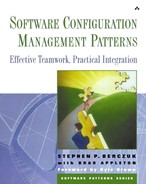Book Description
Effective software configuration management (SCM) strategies promote a healthy, team-oriented culture that produces better software. Software Configuration Management Patterns alleviates software engineers' most common concerns about software configuration management—perceived rigidity and an overemphasis on process.
Through the use of patterns, the authors show that a properly managed workflow can avert delays, morale problems, and cost overruns. The patterns approach illustrates how SCM can be easily and successfully applied in small- to mid-size organizations. By learning how these patterns relate to each other, readers can avoid common mistakes that too often result in frustrated developers and reduced productivity.
Key coverage includes instruction on how to:
Develop the next version of a product while fixing problems with the current one.
Develop code in parallel with other developers and join up with the current state of codeline.
Identify what versions of code went into a particular component.
Analyze where a change happened in the history of a component's development.
Use current tools more effectively, and decide when to use a manual process.
Incrementally introduce good practices into individual workspaces and throughout the organization.
Identify crucial aspects of the software process so that team projects can run smoothly.
Build and foster a development environment focused on producing optimal teamwork and quality products.
Software Configuration Management Patterns also includes a detailed list of SCM tools and thorough explanations of how they can be used to implement the patterns discussed in the book. These proven techniques will assist readers to improve their processes and motivate their workforce to collaborate in the production of higher quality software.
0201741172B09202002
Table of Contents
- Copyright
- The Software Patterns Series
- List of Figures
- Foreword
- Preface
- Contributor's Preface
- Acknowledgments
- Introduction
- I. Background
- II. The Patterns
- 4. Mainline
- 5. Active Development Line
- 6. Private Workspace
- 7. Repository
- 8. Private System Build
- 9. Integration Build
- 10. Third Party Codeline
- 11. Task Level Commit
- 12. Codeline Policy
- 13. Smoke Test
- 14. Unit Test
- 15. Regression Test
- 16. Private Versions
- 17. Release Line
- 18. Release-Prep Code Line
- 19. Task Branch
- 20. Referenced Patterns
- A. SCM Resources Online
- The Configuration Management Yellow Pages
- CM Crossroads—Online Community and Resource Center for CM Professionals
- CM Today—Daily Configuration Management News
- UCM Central—Unified Configuration Management
- ACME—Assembling Configuration Management Environments (for Software)
- The Software Engineering Institute's SCM Publications
- Steve Easterbrook's Configuration Management Resource Guide
- The Software Configuration Management FAQ
- The Association for Configuration and Data Management
- Software Engineering Resource List for Software Configuration Management
- R. S. Pressman and Associates Software Engineering Resources for SCM
- SEWEB Software Configuration Management Resources at Flinders University
- Pascal Molli's “CM Bubbles” SCM Resources Page
- The Usenet Newsgroup Comp.Software.Config-Mgmt
- B. Tool Support for SCM Patterns
- Photo Credits
- About the Photos
- Bibliography
